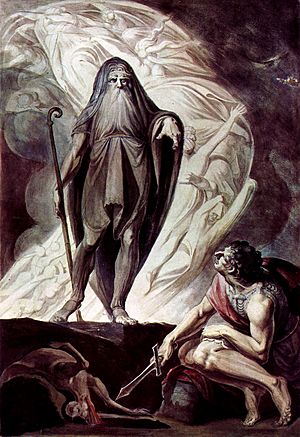Nekyia facts for kids

In ancient Greece, a nekyia (pronounced NEK-yoo-yah) was a special ritual. It was a way to call up ghosts or spirits of the dead. People would question these spirits about the future. This practice is also known as necromancy.
A nekyia is different from a katabasis. A katabasis is a real, physical journey to the underworld. Many heroes in Greek and Roman myths made such a journey. Both a nekyia and a katabasis allowed people to talk with the dead. But only a katabasis meant actually going to the land of the dead. Sometimes, people use the word "nekyia" to mean both types of events.
Contents
Talking with Ghosts: Ancient Rituals
Ancient Greeks and Romans had special places for talking to ghosts. These places were often caverns or deep caves. They believed these spots connected the living world to the underworld.
The most famous place was the Necromanteion in Ephyra, Greece. Other sites for speaking with the dead included Taenaron and Avernus. People could also perform these rituals at a tomb.
Some gods were linked to the nekyia ritual. These included Hades, the god of the underworld, and his wife Persephone. Hecate, a goddess of magic, was also involved. Hermes, the messenger god, helped too. He was known as a psychopompus, meaning he guided souls to Hades.
Odysseus's Journey to the Underworld
The oldest story about a nekyia is in Book 11 of the Odyssey. This part of the epic poem was even called the Nekyia in ancient times. The hero Odysseus was told to make a very different journey. He had to find his way to the Halls of Hades. This meant crossing the River of Ocean.
There, Odysseus spoke with the soul of the prophet Teiresias. He wanted to know how to get back home to Ithaca. The scene was full of ghosts and dark blood. It had eerie noises, like a spooky painting. Odysseus sacrificed a ram and an ewe. This made many spirits of the dead gather around him. He then met and talked to them.
Other heroes also made journeys to the underworld. For example, Herakles had his own "descent" (katabasis). But his journey was different from Odysseus's nekyia. The playwright Aeschylus also wrote about nekyiai. His plays Persians and Libation Bearers show rituals at tombs.
Returning alive from the underworld was a huge achievement for a mortal. Aeneas, another hero, actually went into the House of Hades. He traveled through the world of the dead. Odysseus only went to the entrance to perform his ritual. He summoned spirits to gain knowledge.
Menippus and Lucian's Satire
Lucian of Samosata wrote a funny story around 161–162 CE. It was called Menippus or the Necromancy. It might be based on a lost work by the philosopher Menippus.
In Lucian's story, Menippus was confused. Different writers told different tales about the afterlife. So, he decided to find the truth himself. He got help from a Babylonian magician named Mithrobarzanes. Together, they visited the underworld. They saw famous mythological places. These included Pyriphlegethon, the fiery river, and Cerberus, the three-headed dog. They also saw the palace of Pluto and Charon, the ferryman.
Lucian used the underworld setting to make fun of powerful people. He also used it to poke fun at philosophers.
Nekyia in Psychology
The famous psychologist C. G. Jung used the idea of nekyia in his work. He saw nekyia as a journey inward. It was like the conscious mind exploring the deeper parts of the unconscious mind. For Jung, this journey was not aimless. It was a meaningful "descent" (katabasis). Its goal was to make a person whole again.
Jung also used the idea of a "night sea-journey." This was like going into the belly of a monster. He saw it as a journey to a deeper, hidden part of oneself. His followers also saw these as similar ideas. They were metaphors for exploring the "dark depths of the unconscious."
James Hillman, another psychologist, made some clear differences. He said the hero's night sea-journey helps them return stronger. But a nekyia takes the soul into a deep place for its own sake. There is no "return" in the same way. The night sea-journey creates inner heat. The nekyia goes to a place of utter coldness.
Hillman suggested that we often fear our unconscious minds. We might try to avoid it with "kind feelings" or "sharing." But he believed a true "classical descent" into it, a nekyia, was needed. He felt that after his own "nekyia," Sigmund Freud could finally reach his goals.
See also

